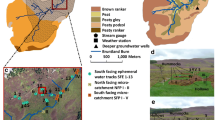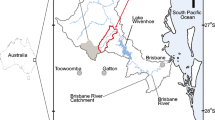Abstract
Developing a more thorough understanding of water and chemical budgets in wetlands depends in part on our ability to quantify time-varying interactions between ground water and surface water. We used a combined water and solute mass balance approach to estimate time-varying ground-water discharge and recharge in the Everglades Nutrient Removal project (ENR), a relatively large constructed wetland (1544 hectare) built for removing nutrients from agricultural drainage in the northern Everglades in South Florida, USA. Over a 4-year period (1994 through 1998), ground-water recharge averaged 13.4 hectare-meter per day (ha-m/day) or 0.9 cm/day, which is approximately 31% of surface water pumped into the ENR for treatment. In contrast, ground-water discharge was much smaller (1.4 ha-m/day, or 0.09 cm/day, or 2.8% of water input to ENR for treatment). Using a water-balance approach alone only allowed net ground-water exchange (discharge — recharge) to be estimated (−12±2.4 ha-m/day). Discharge and recharge were individually determined by combining a chloride mass balance with the water balance. For a variety of reasons, the ground-water discharge estimated by the combined mass balance approach was not reliable (1.4±37 ha-m/day). As a result, ground-water interactions could only be reliably estimated by comparing the mass-balance results with other independent approaches, including direct seepage-meter measurements and previous estimates using ground-water modeling. All three independent approaches provided similar estimates of average ground-water recharge, ranging from 13 to 14 ha-m/day. There was also relatively good agreement between ground-water discharge estimates for the mass balance and seepage meter methods, 1.4 and 0.9 ha-m/day, respectively. However, ground-water-flow modeling provided an average discharge estimate that was approximately a factor of four higher (5.4 ha-m/day) than the other two methods. Our study developed an initial understanding of how the design and operation of the ENR increases interactions between ground water and surface water. A considerable portion of recharged ground water (73%) was collected and returned to the ENR by a seepage canal. Additional recharge that was not captured by the seepage canal only occurred when pumped inflow rates to ENR (and ENR water levels) were relatively high. Management of surface water in the northern Everglades therefore clearly has the potential to increase interactions with ground water.
Similar content being viewed by others
Literature Cited
Abtew, W. and V. Mullen. 1997. Water budget analysis for the Everglades Nutrient Removal Project. SFWMD, West Palm Beach, FL, USA. Technical Memorandum, WRE#354.
Biedenharn, D. and F. Tracy. 1987. Finite element method package for solving steady-state seepage problems. Department of the Army, Corps of Engineers, Waterways Experimental Station, Vicksburg, MS, USA. Technical Report ITL-87-6.
Brigham Young University (BYU) Engineering Computer Graphics Laboratory. 1993. FastSEEP, Automated Seepage Modeling. Provo, UT, USA.
Carter, V. 1986. An overview of the hydrologic concerns related to wetlands in the United States. Canadian Journal of Botany 64: 364–374.
Crowe, A. S. and F. W. Schwartz. 1985. Application of a lakewatershed model for the determination of water balance. Journal of Hydrology 81:1–26.
Good, R. E., D. F. Whigham, and R. L. Simpson. 1978. Freshwater Wetlands. Academic Press, San Diego, CA, USA.
Guardo, M. 1999. Hydrologic balance for a subtropical treatment wetland constructed for nutrient removal. Ecological Engineering 12:315–337.
Guardo, M. and A. A. Prymas. 1998. Calibration of steady state seepage simulations to estimate subsurface seepage into an artificial wetland. p. 555–561. In Engineering Approaches to Ecosystem Restoration. Proceedings of the Conference American Society of Civil Engineers, Denver, CO, USA.
Harvey, J. W., and W. E. Odum. 1990. The influence of tidal marshes on upland groundwater discharge to estuaries. Biogeochemistry 10:217–236.
Harvey, J. W., S. L. Krupa, J. Gefvert, J. Choi, R. H. Mooney, and J. B. Giddings. 2000. Interaction between groundwater and surface water in the Northern Everglades and the relation to water budgets and mercury cycling, Draft final report for cooperative Research Agreement C-6661. U.S. Geological Survey Open-File Report 00-168.
Hemond, H. F., J. C. Goldman. 1985. On non-darcian water flow in peat. Journal of Ecology 73:579–584.
Hemond, H. F. and J. Benoit. 1988. Cumulative impacts on water quality functions of wetlands. Environmental Management 12: 639–653.
Howes, B. L., P. K. Weiskel, D. D. Goehringer, and J. M. Teal 1996. Interception of freshwater and nitrogen transport from uplands to coastal waters: The role of saltmarshes. In K. F. Nordstrom and C. T. Roman (eds.) Estuarine Shores: Evolution, Environments and Human Alterations. John Wiley, New York, NY, USA.
Hunt, R. J., D. P. Krabbenhoft, and M. P. Anderson. 1996. Groundwater inflow measurements in wetland systems. Water Resources Research 32:495–507.
Hutcheon Engineers. 1996. Everglades construction project storm-water treatment area No. 1-W Works—Contract No. C-E101 Amendment No. 1: Supplement to the detailed design report. Hutcheon Engineers, West Palm Beach, FL, USA.
Ingram, H. A., D. W. Rycroft, and D. J. A. Williams. 1974. Anomalous transmission of water through certain peats. Journal of Hydrology 22:213–218.
Ivanov, K. E. 1981. Water Movement in Mirelands. Academic Press. San Diego, CA, USA.
Kadlec, J. A. 1983. Water budgets for small diked marshes. Water Resources Bulletin 19:223–229.
Krabbenhoft, D. P., and M. P. Anderson. 1986. Use of a numerical groundwater-flow model for hypothesis testing. Ground Water 24: 49–55.
LaBaugh, J. L. 1985. Uncertainty in phosphorous retention, Williams Fork Reservoir, Colorado. Water Resources Research 21: 1684–1692.
LaBaugh, J. L., T. C. Winter, D. O. Rosenberry, P. F. Schuster, M. M. Reddy, and G. R. Aiken. 1997. Hydrological and chemical estimates of the water balance of a closed-basin lake in north central Minnesota. Water Resources Research 33:2799–2812.
LaBaugh, J. L. 1986. Wetland ecosystem studies from a hydrologic perspective. Water Resources Bulletin 22:1–10.
Meyer, S. L. 1975. Data Analysis for Scientists and Engineers. John Wiley, New York, NY, USA.
Moustafa, M. Z. 1999. Nutrient retention dynamics of the Everglades nutrient removal project. Wetlands 19:689–704.
Nuttle, W. K., and J. W. Harvey. 1995. Fluxes of water and solute in a coastal wetland sediment: the contribution of regional groundwater discharge. Journal of Hydrology 164:89–107.
Stauffer, R. E. 1985. Use of solute tracers released by weathering to estimate groundwater inflow to seepage lakes. Environmental Science and Technology 19:405–411.
Taylor, J. R. 1982. An Introduction to Error Analysis: The Study of Uncertainties in Physical Measurements. University Science Books, Mill Valley, CA, USA.
Winter, T. C. 1981. Uncertainties in estimating the water balance of lakes. Water Resources Bulletin 17:82–115.
Author information
Authors and Affiliations
Corresponding author
Rights and permissions
About this article
Cite this article
Choi, J., Harvey, J.W. Quantifying time-varying ground-water discharge and recharge in wetlands of the northern florida Everglades. Wetlands 20, 500–511 (2000). https://doi.org/10.1672/0277-5212(2000)020<0500:QTGDAR>2.0.CO;2
Received:
Revised:
Accepted:
Published:
Issue Date:
DOI: https://doi.org/10.1672/0277-5212(2000)020<0500:QTGDAR>2.0.CO;2




